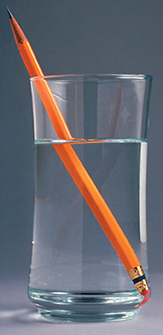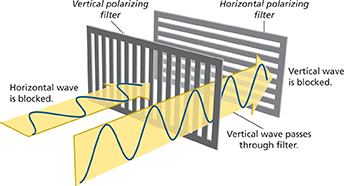Refraction
A light wave can refract, or bend, when it passes at an angle from one medium into another. You can easily observe two common effects of refraction when light travels from air into water. Refraction makes underwater objects appear closer and larger than they really are. Refraction can also make an object, such as a pencil, appear to break at the surface of the water, as shown in Figure 19.
Refraction can also sometimes cause a mirage. A mirage is a false or distorted image. Mirages occur because light travels faster in hot air than in cooler, denser air. On a sunny day, air tends to be hotter just above the surface of a road than higher up. Normally, light travels from the sun all the way to the ground before being reflected. But on a hot day, light is gradually refracted as it moves into layers of hotter and hotter air. This gradual refraction causes some of the light to follow a curved path, rather than a straight path to the ground. Light that reaches your eyes after traveling in this manner can look as if it was reflected from a layer of water. Mirages also form this way above the hot sand in deserts.
Figure 19 Light refracts, or bends, when it moves from one medium to another. Because the light bends, the image you see appears to be bent as well. Relating Cause and Effect Why does the underwater part of the pencil appear to be closer to you than the part above water?

Polarization
Light with waves that vibrate in only one plane is polarized light. Polarizing filters transmit light waves that vibrate in this way. Look at Figure 20. Unpolarized light vibrates in all directions. A vertical polarizing filter stops waves vibrating on a horizontal plane. Waves vibrating on a vertical plane pass through. A horizontal polarizing filter then blocks the waves vibrating on a vertical plane. To understand how a polarizing filter works, think of a light wave as being like a postcard that you push through a mail slot in a door. If you hold the postcard so that it lines up with the mail slot, then you can easily push it through. But if the postcard is at an angle to the mail slot, it has trouble passing through. In the same way, a polarizing filter blocks waves with electric fields vibrating in one direction.
Figure 20 This simplified model shows how polarizing filters behave. A vertical polarizing filter blocks light that is horizontally polarized.
Applying Concepts What would happen if you looked at light through a horizontally polarizing filter and a vertically polarizing filter at the same time?
 d
d




